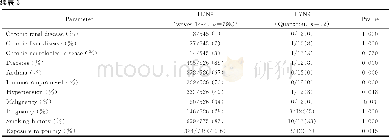《Table 4Laboratory tests of 61 H7N9-induced ARDS patients of in experimental group and control group
 提示:宽带有限、当前游客访问压缩模式
提示:宽带有限、当前游客访问压缩模式
本系列图表出处文件名:随高清版一同展现
《间充质干细胞治疗人感染H7N9禽流感病毒所致急性呼吸窘迫综合征的临床研究——为新冠病毒肺炎救治提供新策略》
As shown in Table 3,all the baseline of laboratory features showed no statistically significant differences in blood routine indexes,inflammation index,liver function,renal function,and coagulation in the two groups.The procalcitonin(PCT)level and C-reactive protein(CRP)level were both higher in the control group than in the experimental group,while the P value of the former was 0.024.This indicates that the patients in the two groups are comparable in our study.However,the blood routine indexes differed significantly between the experimental group and the control group when the patients were discharged(Table 4).The PCT level was significantly higher in the control group than in the experimental group.Also,the serum creatinine (s Cr)level was significantly higher in the control group than in the experimental group (105.54±96.52 versus 63.00±38.55,P=0.019),showing that the control group had a higher proportion of critically ill patients with more severe renal injury.The levels of creatine kinase (CK),prothrombin time (PT),and D-dimer were significantly higher in the control group compared to the experimental group.As the majority of the laboratory features in both groups aresimilar,the significant differences may be associated with the higher death rate of patients in the control group.
| 图表编号 | XD00195689700 严禁用于非法目的 |
|---|---|
| 绘制时间 | 2020.10.01 |
| 作者 | 陈佳佳、胡晨霞、陈利军、汤灵玲、朱一新、徐小微、陈露、高海女、鲁晓庆、俞亮、戴霞红、项春生、李兰娟 |
| 绘制单位 | State Key Laboratory for Diagnosis and Treatment of Infectious Diseases, National Clinical Research Center for Infectious Diseases, Collaborative Innovation Center for Diagnosis and Treatment of Infectious Diseases, The First Affiliated Hospital, College |
| 更多格式 | 高清、无水印(增值服务) |
查看“Table 4Laboratory tests of 61 H7N9-induced ARDS patients of in experimental group and control group at discharged.”的人还看了
-

- Table 6Lung function tests of four H7N9-induced ARDS patients in experimental group during further follow-up for five ye
-

- 表2 H7N9住院病人临床信息比较与统计学分析Table 2 H7N9in-patient clinical information comparison and statistical analysis
-

- 表3 H7N9住院病人临床生化和实验室检测结果比较Table 3 Clinical biochemistry and laboratory test results for H7N9in-patients





